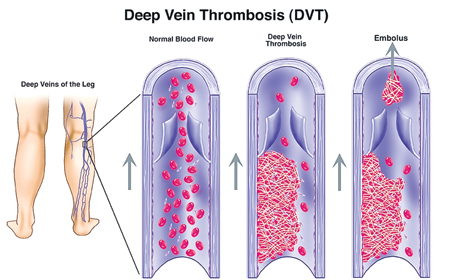
| Blood flow blocked in vein Deep Vein Thrombosis (DVT) is a blood clot that forms in a deep vein in the lower limb, usually resulting in pain and swelling of the leg. Deep veins are the larger veins or blood vessels that take blood back to the heart, through the muscles of the calf and thighs. A DVT partially or completely blocks the blood flow in the vein, depending to what extent the clot has spread across it.
Although relatively uncommon in the normal and active population, DVTs can occur especially after long surgical procedures and cause several complications if not detected in time. Consultant Vascular and Transplant Surgeon, Dr. S.D. Rajamantri, discusses the disease and its symptoms in this interview with MediScene. Why do DVTs occur? Blood flow in leg veins is helped along by leg movements, because muscle action squeezes the veins. Sometimes DVTs can occur for no apparent reason, but the main cause is immobility, especially during surgery - particularly operations to the hip, lower abdomen, and leg. In addition, there are several pre-disposing factors that can increase the risk of DVT.
Symptoms and complications The typical symptoms are pain, tenderness, and swelling of the calf. Blood that would normally go through the blocked vein is diverted to outer veins. The calf may then become swollen and red. Sometimes there are no symptoms and a DVT is only diagnosed if a complication occurs. The most serious complication of DVT is a pulmonary embolus. This is when a part of the clot breaks off and travels in the blood stream - which is known as an embolus. An embolus travels in the veins towards the heart but eventually gets stuck in a blood vessel going to the lungs. This is called a pulmonary embolus. It can cause breathing problems and chest pain, or even be fatal. Also, a DVT may damage the inside lining of the vein, increasing the risk of a blood clot forming. So, if you have a DVT, then you have a higher than average risk of having another one sometime in the future. Left untreated, in extreme cases DVTs can also result in the loss of a leg due to a halt in blood flow. The majority of patients however, end up with disabling symptoms such as chronic swelling and pain in the leg. Diagnosis and treatment Although swelling and pain in the leg do not always indicate a DVT, those who may be at risk due to the above pre-disposing factors should discuss this possibility with their doctor. DVTs are diagnosed by means of a Doppler Scan which locates the blood clots. If diagnosed during the initial stages DVTs can be treated fairly easily with anti-coagulant drugs which prevent a DVT from propagating into the larger veins, as well as any new clots from forming. When the cause of the DVT is specific and temporary - such as surgery or long flights - it is treated with medication for a period of approximately six months. However, if the cause is persistent, such as a clotting disorder, life-long treatment may be necessary. If the disease is diagnosed during the acute stages, urgent treatment including hospitalisation is usually recommended. Patients are also given graduated compression stockings to wear, which direct the blood flow upwards. Preventing a first DVT - or a recurrence of DVT A DVT is often a possible event resulting from another illness or surgery. However, some people have an ongoing risk of a further DVT - for instance, if they have a blood clotting problem or continued immobility. Avoiding a sedentary lifestyle, safety measures during travel - such as taking occasional walks during long flights - and pre-surgical care when having to undergo surgery, to prevent the formation of clots are some of the precautions one can take against DVT. Those with chronic symptoms should continue regular treatment to avoid complications. |
|| Front
Page | News | Editorial | Columns | Sports | Plus | Financial
Times | International | Mirror | TV
Times | Funday
Times | MediScene || |
| |
Copyright
2007 Wijeya
Newspapers Ltd.Colombo. Sri Lanka. |
